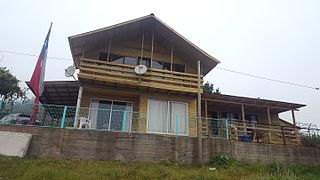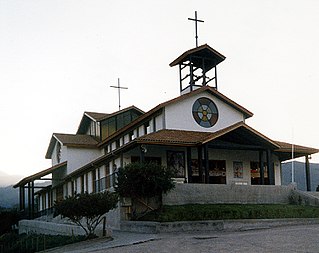
Parral is a city and commune in the Linares Province of Chile's Maule Region.

Cauquenes, a city and commune in Chile, is the capital of the Cauquenes Province and is located in the Maule Region.

San Javier is a Chilean city and commune located in the Province of Linares, Maule Region. The city lies in the geographical center of the country, some 270 km (168 mi) south of Santiago, 31 km (19 mi) to the northwest of the provincial capital, Linares, and 24 km (15 mi) to the south of Talca, the regional capital. The Pan-American Highway passes through the commune of San Javier, touching tangentially the eastern side of the town. A paved road connects San Javier with Colbún, Colbún dam lake and Panimávida and Quinamávida hot springs.

Villa Alegre a commune and city located in Linares Province, Maule Region of Chile. With 189.8 km2 (73 sq mi), Villa Alegre is the smallest commune by area in the Maule Region. It sits 92 m (302 ft) above sea level.

Pelluhue is a town and commune in the Cauquenes Province of central Chile's seventh region of Maule.

Cauquenes Province is one of four provinces of the central Chilean region of Maule (VII). The provincial capital is the city of Cauquenes.
Colbún is a Chilean town and commune in Linares Province, Maule Region. The commune has a population of over 17,000 inhabitants and covers an area of 2,900 km2 (1,120 sq mi), making it the province's largest. Its capital, the town of Colbún, has 3,679 inhabitants. It is 7 km (4 mi) west of the center of continental Chile.

Yerbas Buenas is a Chilean town and commune in Linares Province, Maule Region. It lies in the geographical center of the country, on the fertile central plain, some 300 km (186 mi) south of the national capital of Santiago, 50 km (31 mi) south of Talca, the regional capital and 12 km (7 mi) north of Linares, the provincial capital.

Longaví is a Chilean city and commune located in Linares Province, one of the four provinces that make up the Maule Region, in the geographical center of Chile.
Retiro is a town and commune in Chile, located in Linares Province, in the seventh region of Maule.

San Clemente is a city and commune administered by the municipality of San Clemente, located in the Talca Province of Chile's Maule Region.
Hualañé is a town and commune of the Curicó Province in Chile's seven region of Maule.
Curepto is a town and commune in the Chilean Province of Talca, located in the VII Maule Region. The commune spans an area of 1,073.8 km2 (415 sq mi).
Pencahue is a town and commune in Chile, located in Talca Province, in the seventh region of Maule. The commune spans and area of 956.8 km2 (369 sq mi).
Pelarco is a town and commune in Talca Province, Maule Region of Chile. The commune spans an area of 331.5 km2 (128 sq mi).
San Rafael is a town and commune of the Talca Province in the Maule Region of Chile. The town serves as the communal capital.
Maule is a town and commune in Talca Province in central Chile's Maule Region. It takes its name from the Mapudungun words for "valley" (mau) and "rainy" (len).

El Carmen is a Chilean commune and town in Diguillín Province, Ñuble Region.

Rinconada is a city and commune in the Los Andes Province of central Chile's Valparaíso Region. It was created on 18 January 1897 by Federico Errázuriz Echaurren.
Los Sauces is a Chilean town and commune in the Malleco Province, Araucanía Region.















